Phobos II Launches
On Saturday 11th of March 2000 MARS' most 'high tech' rocket ever screamed in to the skies of Lincolnshire in an attempt to retain the UK amateur rocket altitude record. The flight was one of three altitude attempts made on the day as part of the British National Space Science Centre 'Rocket Challenge 2000' in association with BBC Tomorrows World.
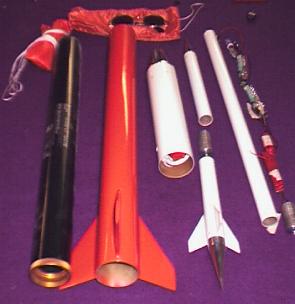
The project started back in January when the BBC approached MARS to help organise the 'Rocket Challenge' event. Despite a lot of problems with trying to find launch sites for the challenge by late February the event was all set to take place on the 11th and 12th of March from a newly acquired launch site in Lincolnshire with three teams competing to break the MARS record of 14,006ft set back in 1998 by 'Transient Glory'.
Initial information on what the other two teams were planning led the MARS team to believe that in order to win by a safe margin their entry for the challenge would have to be capable of reaching an altitude approaching 20,000ft. After weeks of intense computer simulation by Richard Osborne a final design was decided upon and materials were ordered. The design chosen was a true feat of economy and ingenuity. While the other teams were aiming to utilise the 'brute force and ignorance' method of gaining a high altitude with powerful two stagers, MARS realised that a smaller 'boosted dart' design would be far more elegant and efficient.
The vehicle utilised composites and metal for all of its construction. The booster and dart airframes and fins were made from epoxy-fibreglass and the interstage transition and dart nose and tail cones were all turned from solid aluminium. The booster was built around the AeroTech 54/2560 RMS motor and the associated K700 'White Lightning' reload kit. This motor provided an optimum of performance in a small package and was predicted to accelerate the rocket to a maximum speed of over 1000mph over it's three second burn time.
The dart, when completed, was a miracle of careful packing. In order to minimise drag the dart had been made to be only an inch in diameter. This was as small as we could make it and still fit the accelerometer / altimeters needed in to the airframe. The dart contained two 'G-whizz LC Deluxe' accelerometer / altimeters, a 433Mhz location transmitter rigged to transmit back data from the altimeters, a location buzzer, three large custom battery packs, a drogue streamer and a main parachute along with two solid steel bulkhead joints made to increase the weight of the dart closer to it's optimum. All this was packed in to a 3ft long by 1" package.

The MARS team arrived at Pete's farm in Lincolnshire on Friday the 10th to make final preparations for the launch. The West Lancs Rocketry Association team were already there as were Charles Simpson and Pete Davy; the UKRA RSO's overseeing the challenge. At about 11:00pm the team hit a massive problem when it was discovered that one of the two vital location transmitters had been destroyed by accident the week before during tests. A replacement was hastily constructed from what was to hand and by the early hours of Saturday morning Chris Eilbeck had saved the day and the MARS team could get some rest before launch day.
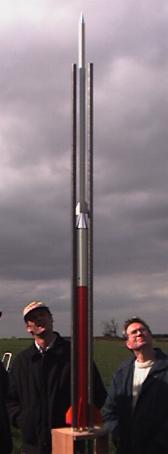
The team spent Saturday morning preparing the electronics package for the dart. By around mid day the teams were asked to finish prep work at the launch site and the prepping operation was moved out to the range. Weather forecasts predicted that the optimum launching conditions would occur on Sunday, this was when the MARS team hoped to make their launch, this would also allow time to complete and run checks on the electronics package. Unfortunately due to budget constraints the BBC told the teams that all three flights must be made on the Saturday so prepping work was speeded up to try and launch before the light we'd need for recovery of the rocket began to fade.
Both the WLRS and SRA two stage rockets were launched flawlessly, screaming out of sight to the appreciation of the spectators and the BBC film crew who were recording the launches with a selection of equipment including high speed cameras next to the launch pads.
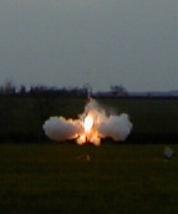
By around 4:00pm the MARS team were allowed to launch and with little fuss the little orange and white rocket was loaded in to the launch tower. At approximately 4:10pm the button was pushed and after a short pause Phobos 2 exploded out of the launch tower atop a six foot column of fire and soared as straight as an arrow in to the sky. Booster burn out was observed and no flight path deviation was noted as the delay charge began burning meaning that a perfect dart separation had occurred.
Chris Eilbeck recorded a signal from what he believed to be the dart transmitter until approximately three minutes after launch, the signal was then lost. All three teams left almost immediately in a planned search pattern to try and locate all three rockets which all used 418 and 433Mhz location transmitters. By around 5:00pm Hugh Gemmel of the SRA had recovered both his booster and his sustainer, the altimeter data was checked and a new altitude record of 14,398ft was recorded...but how long would it stand?
By sundown both the MARS team and the WLRS team had found their boosters. The Phobos 2 booster had apparently suffered a stripped parachute and had impacted soft ground around 1 mile down range but was undamaged. After sunset it was decided that no more could be done and so the search teams gave up until the following morning.
Sunday morning saw an early start for everyone and by 10:00am the MARS team were trekking through a forest armed with GPS units, radio receivers and compasses searching for the dart. The team knew that the on-board batteries would only keep the transmitter and altimeter running until around mid afternoon so speed was vital. At 1:00pm it was decided that little more could be done. If the transmitter had still been operating it would have been detected by then. By 3:00pm the search was completely abandoned and the remaining crew began packing for the trip home.
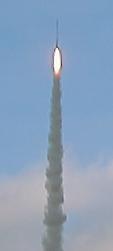

So, on reflection, what has been learnt from this launch? From what we know we have pieced together a likely scenario of what happened. It is thought that the tightly packed streamer in the tail of the dart was either stripped in a high speed deployment or was never deployed at all. The time that the signal was received from the dart for, would be consistent with the streamer deploying though. The small lightweight parachute was probably torn off on deployment at 400 feet, resulting in the dart tumbling in a semi-ballistic descent. Based on the calculated descent rate, the time the signal was received for, and the landing point of the booster, it is predicted that the dart would have come down in the the heart of the forest around 2 miles downrange, the force of the landing would most likely have damaged the on board electronics so severely that the transmitter was not even transmitting when we began our search.
In hindsight we probably went way over the top in trying to make the dart so small to get every last foot of altitude out of it. Given the perfectly vertical nature of the boost and the accuracy of previous simulations we are confident that the dart in fact achieved an altitude well in excess of 18,500ft AGL. We could have made a larger dart with a better recovery system that only went to 15,000 and we'd still have won, but as the MARS saying goes..."If you're gonna fail...fail in style!!!!"
I think that in all honesty it is a good thing that we failed to retain the altitude record. We had become complacent and were convinced that a kit rocket couldn't beat a custom-engineered thoroughbred altitude vehicle.... we were proved wrong. If we had won we'd have rested on our laurels and kicked back to enjoy a year of lazy HPR sport flying, safe in the knowledge that we could always win. Instead MARS are now more enthusiastic and committed than ever before. Members we didn't even know we had have pledged time, money and support to not only winning back the altitude record, but to make sure that by the end of 2000 'MARS' is the name being enviously whispered by every amateur rocketry group in the World. In the words of 'Bachman Turner Overdrive'... "You ain't seen nothin' yet!"
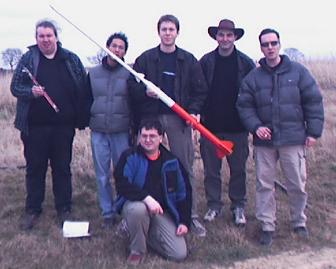
By Ben Jarvis and Iain Colledge










